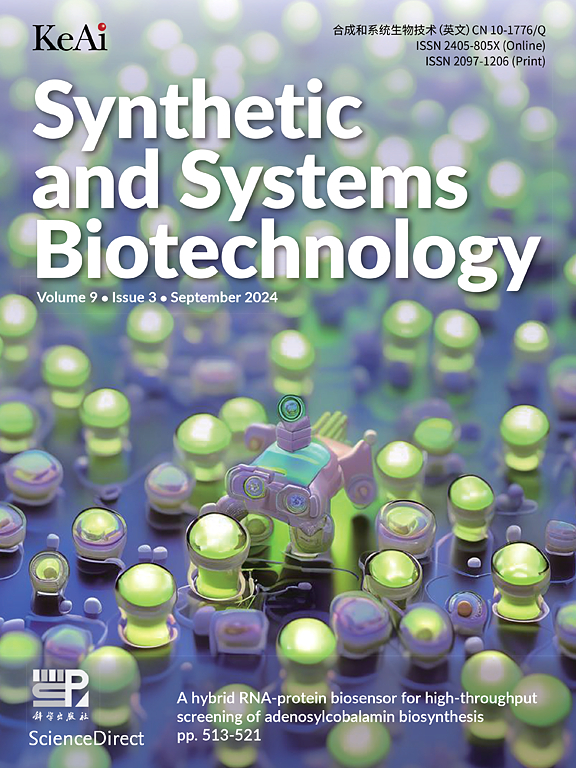Polyhydroxyalkanoate production during electroactive biofilm formation and stabilization in wetland microbial fuel cells for petroleum hydrocarbon bioconversion
IF 4.4
2区 生物学
Q1 BIOTECHNOLOGY & APPLIED MICROBIOLOGY
引用次数: 0
Abstract
This study presented new insights into the sustainable conversion of total petroleum hydrocarbon (TPHC) into polyhydroxyalkanoates (PHAs) using wetland microbial fuel cells (WMFCs). The main innovations included the following two points: (1) The integration of bioelectricity generation with efficient PHA production further underscored the potential of electroactive biofilms as a sustainable platform for simultaneous TPHC biotransformation, bioelectricity recovery and PHA production. (2) The interactive dynamics of PHAs, metabolites, extracellular polymeric substances (EPS) and microorganisms during the formation and stabilization of electroactive biofilms provided novel insights into microbial strategies for carbon utilization. As the electroactive biofilm formed and stabilized, the current density enhanced significantly from 0 to 101 mA m−2, then stabilized, and finally dropped to 3.51 mA m−2. Similarly, the power density showed a trend of increasing in the initial stage, maintaining in the middle stage, and then descending in the later stage. The production of six types of PHAs was identified: poly(3-hydroxybutyrate) [P(3HB)], poly(3-hydroxyvalerate) [P(3HV)], poly(3-hydroxybutyrate-co-3-hydroxyvalerate) [P(3HB-co-3HV)], poly[(R)-3-hydroxybutyrate-co-(R)-3-hydroxyhexanoate] [P(3HB-co-3HHX)], poly(3-hydroxyhexadecanoate) [P(3HHD)] and poly(3-hydroxyoctadecanoate) [P(3HOD)], highlighting the metabolic flexibility of electroactive biofilms. The total PHA content was initially undetectable (days 0–4), gradually increased (days 4–28), rose rapidly (days 28–48), gradually increased and descended (days 48–68). The maximum PHA content of 0.664 g g⁻1 DCW achieved highlighted the dual functionality of WMFCs in bioelectricity production and PHA biosynthesis, distinguishing it from conventional MFC applications. The TPHC biodegradation ratio demonstrated a gradual increase (days 0–28), with a more pronounced rise (days 28–48), and a gradual rise to 76.1 % (days 48–68). Throughout the process, the metabolite volatile fatty acids (VFAs) produced were primarily acetate, propionate, butyrate and valerate. The trend of VFA production from days 0–56 closely followed that of TPHC biodegradation. The trend of tyrosine/tryptophan proteins in EPS was aligned with that of biofilm thickness. The strong correlation between the increase in the biofilm thickness and the intensity and peak height of tyrosine/tryptophan proteins during the first 20 days suggested that these proteins were integral to the structural integrity of the biofilms, and from days 20–64, the minimal variation in their intensity and peak height indicated that the biofilms had reached a relatively stable state. The biofilms in turn provided a stable microbial substrate and energetic support for the subsequent efficient synthesis of PHA. During the early phase, the dual-function bacteria, such as Pseudomonas, Bacillus, Acinetobacter and Desulfosarcina, prioritized electron transfer and bioelectricity production using available carbon sources. As bioelectricity generation became less critical in the later phase, the bacteria shifted to intracellular PHA accumulation, transitioning from bioelectricity production to PHA biosynthesis. Finally, a comprehensive network connecting functional microorganisms with bioelectricity production, PHA content, TPHC biodegradation, VFA production and EPS peak height was established. Overall, these findings provided valuable insights into the dynamic interactions and metabolic strategies of electroactive biofilms in WMFCs, highlighting their potential for the efficient bioconversion of PHCs into PHAs.
用于石油烃生物转化的湿地微生物燃料电池电活性生物膜形成和稳定化过程中聚羟基烷酸酯的产生
该研究为利用湿地微生物燃料电池(wmfc)将总石油烃(TPHC)可持续转化为聚羟基烷酸酯(PHAs)提供了新的见解。主要创新包括以下两点:(1)生物发电与高效PHA生产的结合进一步凸显了电活性生物膜作为同时进行TPHC生物转化、生物电回收和PHA生产的可持续平台的潜力。(2)电活性生物膜形成和稳定过程中pha、代谢物、胞外聚合物(EPS)和微生物的相互作用动力学为微生物的碳利用策略提供了新的见解。随着电活性生物膜的形成和稳定,电流密度从0到101 mA m−2显著增强,然后趋于稳定,最后降至3.51 mA m−2。同样,功率密度在初始阶段呈上升趋势,在中期保持不变,然后在后期下降。鉴定了六种类型的相体:聚(3-羟基丁酸酯)[P(3HB)]、聚(3-羟基戊酸酯)[P(3HV)]、聚(3-羟基丁酸酯-co-3-羟基戊酸酯)[P(3HB-co-3HV)]、聚((R)-3-羟基丁酸酯-co-(R)-3-羟基己酸酯][P(3HB-co- 3hhx)]、聚(3-羟基十六酸酯)[P(3HHD)]和聚(3-羟基十八酸酯)[P(3HOD)],突出了电活性生物膜的代谢灵活性。总PHA含量最初(0 ~ 4 d)检测不到,逐渐升高(4 ~ 28 d),迅速上升(28 ~ 48 d),逐渐升高并下降(48 ~ 68 d)。最大PHA含量为0.664 g g - 1 DCW,突出了wmfc在生物发电和PHA生物合成方面的双重功能,将其与传统MFC应用区分开来。TPHC生物降解率在0 ~ 28天呈逐渐上升趋势,28 ~ 48天上升更为明显,48 ~ 68天逐渐上升至76.1%。在整个过程中,产生的代谢产物挥发性脂肪酸(VFAs)主要是醋酸酯、丙酸酯、丁酸酯和戊酸酯。0 ~ 56 d VFA产量变化趋势与TPHC生物降解趋势密切相关。EPS中酪氨酸/色氨酸蛋白的变化趋势与生物膜厚度的变化趋势一致。在前20天,生物膜厚度的增加与酪氨酸/色氨酸蛋白的强度和峰高之间存在很强的相关性,这表明这些蛋白是生物膜结构完整性的组成部分,从20 - 64天开始,它们的强度和峰高的变化最小,表明生物膜已经达到了相对稳定的状态。生物膜反过来又为PHA的高效合成提供了稳定的微生物底物和能量支持。在早期阶段,双重功能细菌,如假单胞菌、芽孢杆菌、不动杆菌和脱硫菌,优先考虑电子转移和利用可用碳源产生生物电。随着生物发电在后期变得不那么重要,细菌转向细胞内PHA积累,从生物电生产过渡到PHA生物合成。最后,建立了功能微生物与生物电产量、PHA含量、TPHC生物降解、VFA产量和EPS峰高之间的综合网络。总的来说,这些发现为wmfc中电活性生物膜的动态相互作用和代谢策略提供了有价值的见解,突出了它们将PHCs高效生物转化为pha的潜力。
本文章由计算机程序翻译,如有差异,请以英文原文为准。
求助全文
约1分钟内获得全文
求助全文
来源期刊

Synthetic and Systems Biotechnology
BIOTECHNOLOGY & APPLIED MICROBIOLOGY-
CiteScore
6.90
自引率
12.50%
发文量
90
审稿时长
67 days
期刊介绍:
Synthetic and Systems Biotechnology aims to promote the communication of original research in synthetic and systems biology, with strong emphasis on applications towards biotechnology. This journal is a quarterly peer-reviewed journal led by Editor-in-Chief Lixin Zhang. The journal publishes high-quality research; focusing on integrative approaches to enable the understanding and design of biological systems, and research to develop the application of systems and synthetic biology to natural systems. This journal will publish Articles, Short notes, Methods, Mini Reviews, Commentary and Conference reviews.
 求助内容:
求助内容: 应助结果提醒方式:
应助结果提醒方式:


